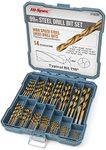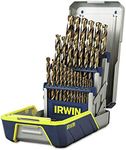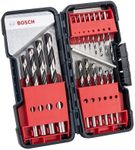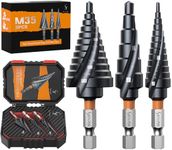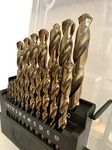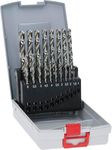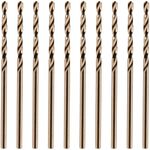Buying Guide for the Best Metal Drill Bits
When selecting metal drill bits, it's important to consider the type of metal you'll be drilling into, as well as the specific requirements of your project. Metal drill bits are designed to cut through various types of metal, and choosing the right one can make your work more efficient and precise. Understanding the key specifications will help you select the best drill bit for your needs, ensuring durability and effectiveness.MaterialThe material of the drill bit is crucial because it determines the bit's durability and effectiveness in cutting through metal. Common materials include high-speed steel (HSS), cobalt, and carbide. HSS is suitable for general-purpose drilling in softer metals, while cobalt bits are more heat-resistant and ideal for harder metals like stainless steel. Carbide bits are the hardest and most durable, perfect for heavy-duty drilling in very hard metals. Choose the material based on the hardness of the metal you will be drilling.
CoatingCoatings on drill bits enhance their performance by reducing friction and increasing durability. Common coatings include black oxide, titanium, and nitride. Black oxide provides corrosion resistance and is suitable for general use. Titanium coatings increase the bit's hardness and heat resistance, making them ideal for drilling harder metals. Nitride coatings offer even greater durability and are used for high-performance applications. Consider the coating based on the frequency of use and the type of metal you are working with.
SizeThe size of the drill bit is important because it determines the diameter of the hole you will create. Drill bits come in a wide range of sizes, typically measured in inches or millimeters. Smaller bits are used for precision work and creating smaller holes, while larger bits are used for bigger holes. Choose the size based on the specific requirements of your project, ensuring it matches the size of the screws or bolts you plan to use.
Point AngleThe point angle of a drill bit affects how it cuts into the metal. Common point angles are 118 degrees and 135 degrees. A 118-degree angle is suitable for softer metals and general-purpose drilling, providing a sharper point for easier penetration. A 135-degree angle is flatter and more robust, ideal for harder metals as it reduces walking and provides better control. Select the point angle based on the type of metal and the precision required for your project.
Flute DesignThe flute design of a drill bit refers to the grooves that spiral around the bit, which help remove chips and debris from the hole. Standard flutes are suitable for most drilling tasks, while parabolic flutes are designed for deep hole drilling, providing better chip removal. Consider the flute design based on the depth of the holes you need to drill and the type of metal, ensuring efficient chip removal and preventing bit clogging.

